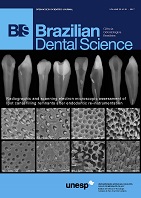Influence of chlorhexidine on longitudinal bond strength to dentin: in vitro study
DOI:
https://doi.org/10.14295/bds.2017.v20i1.1315Resumo
Objective: This study evaluated the effect of 0.2% chlorhexidine gluconate solution used as an therapeutic primer on the long-term bond strength of etch-and-rinse adhesive to dentin. Material and Methods: Bovine incisors were worn to expose an area of dentin and were divided into 2 groups: Group C (Control) - acid etching with 37% phosphoric acid + Single Bond; Group CHX (0.2% CHX) - acid etching with 37% phosphoric acid + 0.2% CHX for 30 s + Single Bond. Blocks of composite were fabricated and stored for 24 h or 6 months, sectioned into beams and submitted to microtensile tests. Results were analyzed by two-way ANOVA and Tukey tests. Results: Mean (±SD) values (in MPa) were as follow: Group CHX/24h - 41.8(±2.62)A; Group C/24h - 40.8(±3.35)AB; Group CHX/6 months – 36.4(±3.52)B; Group CHX/6 months - 26.1(±1.54)C. Conclusion: CHX improve the imediatte bond strength of resin-dentin and significantly lowered the loss of bond strength after 6 months water storage as seen in the control bonds.
Keywords
Tensile bond strength; Dentin; Total-etch adhesives; Chlorhexidine gluconate.
Downloads
Downloads
Publicado
Como Citar
Edição
Seção
Licença
TRANSFERÊNCIA DE DIREITOS AUTORAIS E DECLARAÇÃO DE RESPONSABILIDADE
Toda a propriedade de direitos autorais do artigo "____________________________________________________________________" é transferido do autor(es) para a CIÊNCIA ODONTOLÓGICA BRASILEIRA, no caso do trabalho ser publicado. O artigo não foi publicado em outro lugar e não foi submetido simultaneamente para publicação em outra revista.
Vimos por meio deste, atestar que trabalho é original e não apresenta dados manipulados, fraude ou plágio. Fizemos contribuição científica significativa para o estudo e estamos cientes dos dados apresentados e de acordo com a versão final do artigo. Assumimos total responsabilidade pelos aspectos éticos do estudo.
Este texto deve ser impresso e assinado por todos os autores. A versão digitalizada deverá ser apresentada como arquivo suplementar durante o processo de submissão.




























